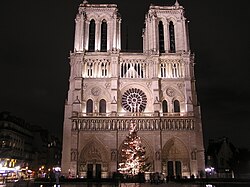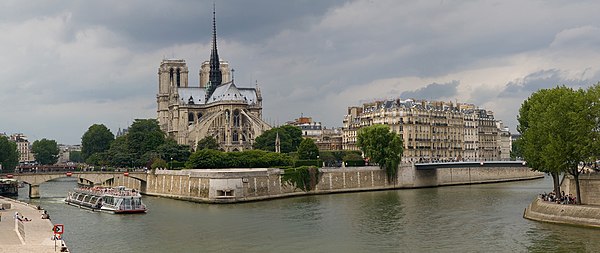
The Louvre Museum (French: Musée du Louvre) in Paris, France, is the most visited and one of the oldest, largest and most famous art galleries and museums in the world. The Louvre has a long history of artistic and historic conservation, from the Capetian dynasty until today. The building was previously a royal palace, and is famous for holding several of the world's most prestigious works of art, such as Leonardo da Vinci's Mona Lisa, The Virgin and Child with St. Anne, Madonna of the Rocks and Alexandros of Antioch's Venus de Milo. Located in the centre of the city of Paris, between the Rive Droite of the Seine and the rue de Rivoli in the Ier arrondissement, it is accessed by the Palais Royal — Musée du Louvre Metro station. The equestrian statue of Louis XIV constitutes the starting point axe historique, but the palace is not aligned on this axis.
With a record 8.3 million visitors received in 2006[1], the Louvre is widely seen as the most visited culture and art museum in the world. It's also the most visited monument in Paris.
Innovations

Notre Dame de Paris was one of the first Gothic cathedrals, and its construction spanned the Gothic period. Its sculptures and stained glass show the heavy influence of naturalism, giving them a more secular look that was lacking from earlier Romanesque architecture.
Notre Dame de Paris was among the first buildings in the world to use the flying buttress. The building was not originally designed to include the flying buttresses around the choir and nave after the construction began and the thinner walls (popularized in the Gothic) grew ever higher, stress fractures began to occur as the walls pushed outward. The buttresses were added to prevent further deterioration. For many years, the buttresses were reviled as it was said they looked "like scaffolding" someone had forgotten to remove and gave the cathedral an "unfinished" look.
Features

The western façade of the cathedral is the single most well-known feature. It is divided into three distinct levels, a holdover from Romanesque architecture. The image to the right indicates some of the west front's most significant features. - Preceded by a Gallo-Roman temple to Jupiter, a Christian basilica, and a Romanesque church, construction of Notre Dame de Paris began in 1163 during the reign of Louis VII. Pope Alexander III laid the foundation stone. The idea to replace the Romanesque church occupying the site - the Cathedral of St. Etienne (founded by Childebert I in 528) - was that of Bishop Maurice de Sully (who died in 1196). (Some accounts claim that there were two churches existing on the site, one to the Virgin Mary, the other to Saint Stephen.) Construction was completed roughly 200 years later in about 1345. The choir was completed in 1182; the nave in 1208, and the west façade and towers circa 1225-1250 (even though the towers are considered "massive", they are still incomplete). A series of chapels were added to the nave during the period 1235-50, and during 1296-1330 to the apse (Pierre de Chelles and Jean Ravhoey). The transept crossings were built in 1250-67 by Jean de Chelles and Pierre de Montreuil (also the architect of the Sainte-Chapelle). It was essentially completed according to the original plans.
Though several organs were installed in the cathedral over time, the earliest ones were inadequate to the building. The first noteworthy organ was finished in the early 1700s by the noted builder Cliquot. Some of Clicquot's original pipework in the pedal division continues to sound from the organ today, almost 270 years after being installed. The organ was almost completely rebuilt and expanded in the nineteenth century by Aristide Cavaillé-Coll. The position of titular organist at Notre-Dame is considered as one of the most prestigious organist posts in France, along with the titulaire post of Saint Sulpice in Paris, Cavaillé-Coll's largest instrument. The organ has 7800 pipes with 900 classified as historical. The organ has 109 stops, five 56-key manuals and a 32-key pedalboard. In December of 1992 work was completed on the organ that fully computerized the organ under 3 LANs (Local Area Networks). Among the best-known organists at Notre Dame was Louis Vierne, who held this position from 1900 to 1937. Under his tenure, the Cavaillé-Coll organ was modified in its tonal character, notably in 1902 and 1932. Pierre Cochereau initiated further alterations (many of which were already planned by Louis Vierne), including the electrification of the action between 1959 and 1963 (the original Cavaillé-Coll console, which can still be seen at the organ loft as a tribute to Louis Vierne, was replaced by a new console in Anglo-American style) and the addition of further stops between 1965 and 1972, notably in the pedal division, the recomposition of the mixture stops, and finally the adding of three horizontal reed stops "en chamade". After Cochereau's sudden death in 1984, four new titular organists were appointed at Notre Dame in 1985: Jean-Pierre Leguay, Olivier Latry, Yves Devernay (who died in 1990), and Philippe Lefévre. This was reminiscent of the eighteenth century practice of the cathedral having four titular organists, each one playing for three months of the year. Beginning in 1989, another restoration to the instrument was undertaken, which was completed in 1992.







No comments:
Post a Comment